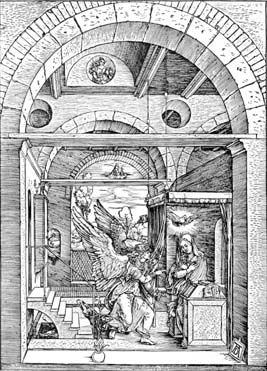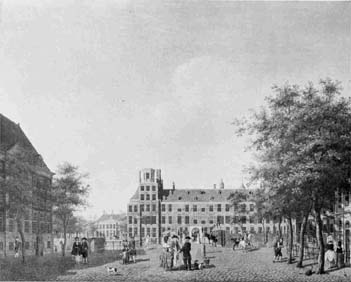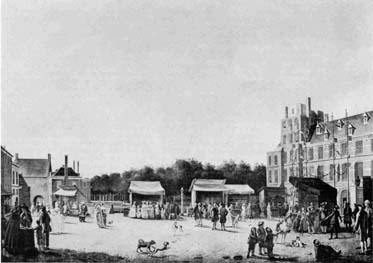
Bulletin 3 (II:1), 1964
Home
Français
Introduction
History
Annual Index
Author &
Subject
Credits
Contact



Notes on
an Eighteenth-Century Dutch Painting
by William A. Blom, Research Curator
Pages 1 | 2
| 3
In this unusually quiet View of the West Church at
Amsterdam, van der Heyden shows a wall with an arched gateway
surrounding the church. This wall does not appear in Ouwater's
painting. Instead, it shows two handsome doorways, one of which, on
the left, had presumably not yet been built in van der Heyden's
time. The merchant's house to the right of the church appears in
both paintings, but its clean and neat appearance would suggest that
it had undergone restoration shortly before Ouwater painted it. The
guard-house on the left in Ouwater's painting is obscured by trees
in van der Heyden's view. The trees in Ouwater's painting are fairly
young and some of those shown in van der Heyden's painting must have
been removed, opening vistas of the fine houses on the Prinsengracht
beyond either side of the church. Along the stone parapet of the
canal in Ouwater's painting there is a railing which is not present
in van der Heyden's view. The foreground of van der Heyden's
painting clearly indicates the curve in the canal. The figures are
carefully placed and move freely within the architectural
background, and supply the rather lively highlighting in the
foreground. A prosperous stroller, accompanied by a youth with his
dog and a Negro servant, seem to set the leisurely and peaceful
atmosphere of this view. Ouwater hardly indicates the curve of the
canal, the treatment of the foreground tends to be flat, and the
figures blend with the background.
Ouwater's strict observation betrays little emotion. His meticulous
graphic approach contrasts with that of van der Heyden who, also
using a most carefully considered style, displays greater depth,
warmth of feeling, and a very graceful use of sunlight effect.
Despite there being no trace of imitation in the light and
crystalline touch of Ouwater, it is obvious that his inspiration
came from the seventeenth century .The pleasing quality of Ouwater's
overall rendering and, in particular, the luminosity of the sky,
cannot be denied.
Ouwater's contemporaries, amongst whom were Jean de Beyer
(1703-1785), Jan Ekels (1724-1781), Hendrik Pothoven (1725-1795),
Hendrik Keun (1738-1788), who was an imitator of van der Heyden, and
Reinier Vinkeles (1741-1816), are characterized by their direct
study and strict observation of nature. It is in their work that the
foundation was laid for the academic realism that was to predominate
in nineteenth century Dutch painting. There is often great stylistic
similarity amongst these painters, and Ouwater perhaps comes closest
to men like Jan Ekels and especially Hendrik Pothoven. Pothoven was
a portraitist of some merit but his best work is to be found in the
interiors and views of The Hague. His painting of The Family
Stadtholder Willem V visiting the Fair in the Outer Court, in
the Gemeentemuseum, The Hague (Fig. 3), illustrates the similarity
in style when compared to Ouwater's rendering of The Outer Court
at The Hague, in the same museum (Fig. 4).
The work of Isaak Ouwater and his contemporaries reflects a
restricted vision, a preoccupation with refined picturesqueness, and
the portrayal of detail for its own sake. In spite of these
limitations we are irresistably drawn to the inherent charm of
eighteenth century Dutch painting.
Next Page | Notes This digital collection
was produced under contract to Canada's Digital Collections program,
Industry Canada.
1 | 2
| 3
Annual
Index | Author
& Subject | Credits | Contact
"Digital
Collections Program, Copyright
© National Gallery of
Canada 2001"